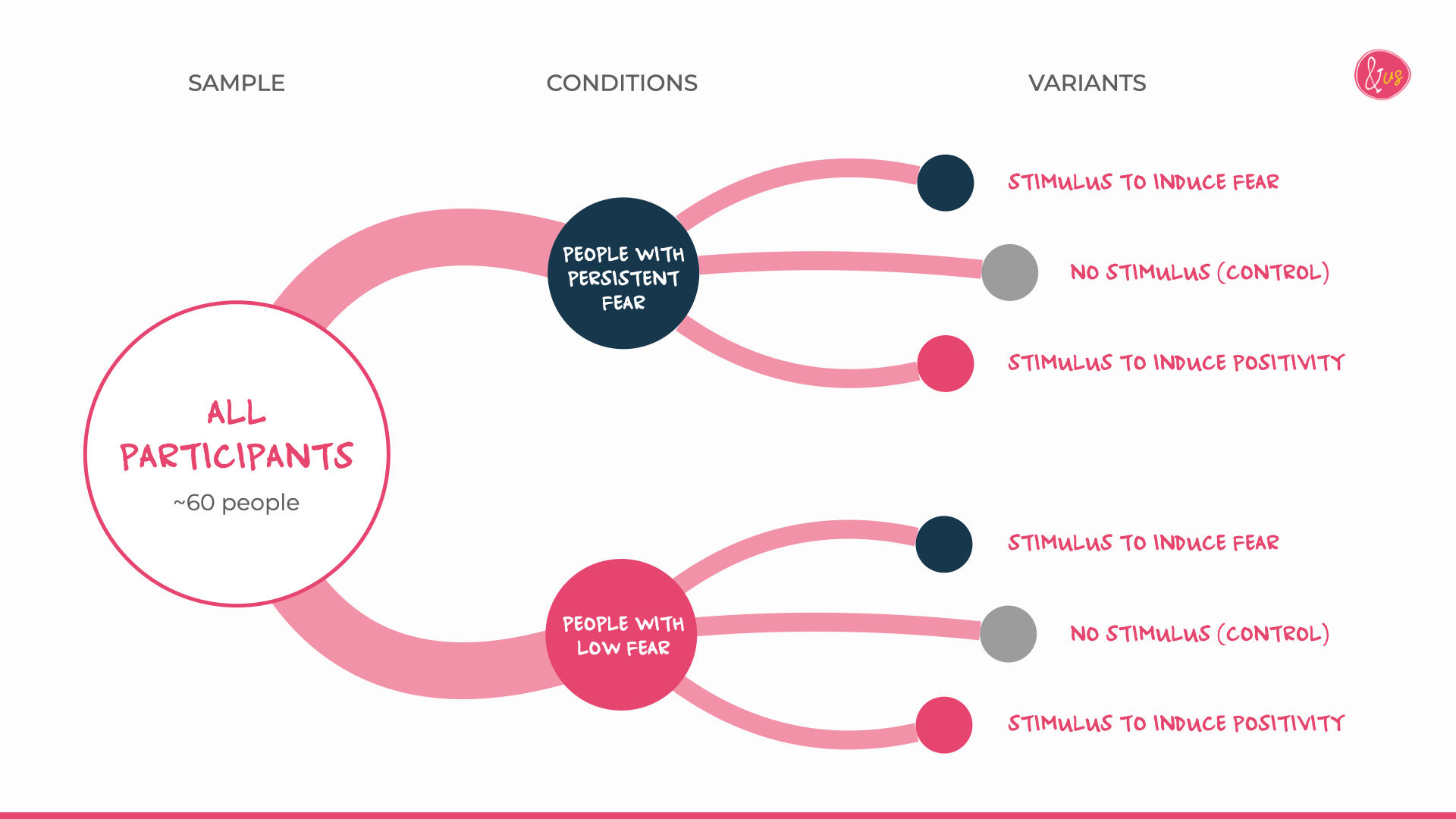Creating a behavioural experiment in the middle of a global pandemic? Sure, why not!
I joined the &us team as a strategist in July to help with Project Fear, a piece of research looking at fear in the workplace and how it interacts with innovation.
The work has exploded into something bigger than we could have anticipated and, despite, at times being overwhelmed with spreadsheets and transcriptions, the insights are fascinating.
Make sure you read the first instalment of the Fear Series to learn about why we care about fear.
Here I’ll be sharing our process of how we came to design a quick and easy experiment so that you can too.
What do people really do when they feel fear?
With a survey of 3,000 members of the public, plus 20 conversations oozing with insight with the UK’s most bright and innovative minds, the Project Fear team had already gathered more data than we knew what to do with, and yet, it still felt like a piece of the puzzle was missing.
Self reporting is useful, but we were interested in the reality:
What do people actually do when they feel fear?
How does it impact behaviour, output, culture? Would it be so crazy to do an experiment to find out?!
Designing for Fear
Experimenting with fear is about as easy as it is ethically sound. In the midst of a global pandemic and economic uncertainty, it felt a strange time to delve into the reality of being scared at work, but we had to try and dig deeper than worldwide COVID-19 related worries.
Obviously, making people feel afraid wasn’t an option, we had to be creative with our approach.
Fear at work exists, everyone knows that. But how might we prime people to help them picture how that feels, or recreate its effects and impacts? Oh — and all entirely remotely.
We browsed scales and questionnaires designed to measure fear, but most focused on mental health effects, or fear of change, which felt too broad and too narrow respectively.
There was only one thing for it — create our own. Snippets from different research papers were patch-worked together to form a bespoke fear screener. It didn’t have to be perfectly scientifically accurate, it just needed to function. Our plan was to categorise participants based on their screener responses as being “Fear” or “No Fear” individuals and observe the differences.
We also wanted to see if beyond these pre-existing ‘fear states’, whether just thinking about fear would affect performance, so we decided to expose a group to stimulus that might prompt them to bring a fearful memory to the front of their mind. We thought we could also do the reverse, and see if bringing hopes and positivity to the front of mind could potentially reduce any bad effects.

Creating hypotheses
Based on existing research and anecdotal evidence, we crafted three clear hypotheses and devised a plan to test them remotely. There was no need to reinvent the wheel, validated experimental designs already exist, so we borrowed them;
Hypothesis 1: Fear makes you slower to complete simple tasks
- Test: We settled on a simple maths test. Easy(ish), quick-fire questions designed to measure speed and accuracy.
Hypothesis 2: Fear makes you less creative
- Test: The Remote Associates test has been validated time and again as a great measure of creativity. Participants are shown 3 words and asked to find a 4th associated word. It’s tricky.
Hypothesis 3: Fear makes you less likely to collaborate
- Test: We turned to Game Theory’s Prisoner’s Dilemma and framed it to present the quandary of choosing to collaborate with or work against a colleague based on the temptation of various financial incentives.
In addition, we included stimulus articles alongside each test, designed to incite feelings of either fear or positivity, (also borrowed these from trusty sources!).
After a few YouTube tutorials and exploration of various remote lab options, I was building our makeshift experiment for real people to do… and it worked! Following a few trial runs, it was set to live and we had over 50 participants.
Experiments for Everyone!
Analysis has begun and the findings are fascinating and unexpected. Our next blog will discuss our learnings, but what we have already seen is the value in throwing something together and giving it a go. Too often, we feel the need for our ideas to be perfectly formed and grounded in meticulous planning when the reality is you can generate powerful output with workarounds.
Conducting a behavioural experiment in a remote lab was new to us, as a business, and as individuals, but we put off the worrying, trusted our process and started by starting. Experimenting is the most powerful way to prove a concept, and yet the fear (ironically) of it going wrong can stop people in their tracks. If our experiment hadn’t seemed to be working, or if our results aren’t what we expect, we can hit pause, admit it wasn’t quite right and try to fix it.
Experiments don’t have to be one-offs, they can become part of your everyday work, they allow teams to kill troublesome ideas and breathe life into the great ones. Doing, making and learning are what make work joyful. Embrace the bold and the new to innovate successfully, give your teams the license to give things a whirl, you won’t regret it.
